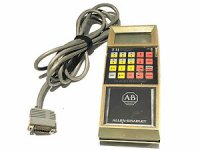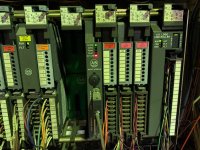Ken Roach
Lifetime Supporting Member + Moderator
Those file extensions are similar to AI-2, but not the same. They are almost entirely unlike 6200-PLC2 software file extensions.
It is probable that they were generated by a different software package. There were a small number of third-party software packages for the PLC-2, including Taylor Software's TOPDOC.
Only CFG, CNT, and XRF files are the same extensions as ICOM / AI-2, and only XRF is the same as Allen-Bradley 6200 PLC2.
6200-PLC2 software got even more obscure, putting files into several subdirectories.
It is probable that they were generated by a different software package. There were a small number of third-party software packages for the PLC-2, including Taylor Software's TOPDOC.
Only CFG, CNT, and XRF files are the same extensions as ICOM / AI-2, and only XRF is the same as Allen-Bradley 6200 PLC2.
Code:
AI-2
FILE
[U]EXTENSION Description[/U]
.ADR Index for description text
.CFG Program Configuration Data (PLC2ll0.cfg)
.CNT Table of contents
.DEL Deleted unused instruction descriptions (ASCII delimited format)
.DSC Instruction description text
.ERR Error message storage
.IOM I/O configuration file
.LAD Ladder Logic
.LIB Blocks of rungs saved to disk
.PRF Program revision history file
.RPD Rung/page titles file
.RPI Index for rung/page titles
.SCR Custom data monitor screen
.RDT Report Header
.SYM Index for description text
.XRF Cross reference file
.XRI Index for cross reference file
.001 Ladder backup file (oldest)
.002 Ladder backup file (next oldest)
.003 Ladder backup file (highest number is most recent)6200-PLC2 software got even more obscure, putting files into several subdirectories.
Code:
6200PLC2 FILE TYPE
Rung comment, instruction comment, address comment, and symbol files.
\IPDS\ARCH\PLC2AB
.AC$
.B0$
.B1$
.IX$
.LX$
.OP$
.PC$
Cross reference files.
.XD$
.X0$
.B2$
Import/Export files:
.TXT
.LOG
Report files.
Contact histogram, Daa table, Force status, Ladder cross reference, Memory map
Memory usage, Program listing, Symbol table, Unused address
\IPDS\LIS\PLC2AB
.HIS
.DTR
.FSR
.XRF
.MMR
.MUR
.LIS
.STR
.UAR
Title file for documentation reports
\IPDS\
.TTL
Program Files:
Processor memory files
Data table files
\IPDS\ARCH\PLC2AB
.PR1
.DA1
User configuration files
\IPDS\ATTACH\PLC2AB
USER2.P23



